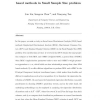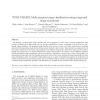1563 search results - page 312 / 313 » Face Hallucination and Recognition |
IJCV
2008
13 years 5 months ago
2008
Object identification (OID) is specialized recognition where the category is known (e.g. cars) and the algorithm recognizes an object's exact identity (e.g. Bob's BMW). ...
PR
2008
13 years 5 months ago
2008
In this paper, we make a study on three Linear Discriminant Analysis (LDA) based methods: Regularized Discriminant Analysis (RDA), Discriminant Common Vectors (DCV) and Maximal Ma...
PRL
2008
13 years 5 months ago
2008
We describe a multi-purpose image classifier that can be applied to a wide variety of image classification tasks without modifications or fine-tuning, and yet provide classificati...
TCSV
2008
13 years 5 months ago
2008
Conventional subspace learning or recent feature extraction methods consider globality as the key criterion to design discriminative algorithms for image classification. We demonst...
TRS
2008
13 years 5 months ago
2008
A popular view is that the brain works in a similar way to a digital computer or a Universal Turing Machine by processing symbols. Psychophysical experiments and our amazing capabi...


